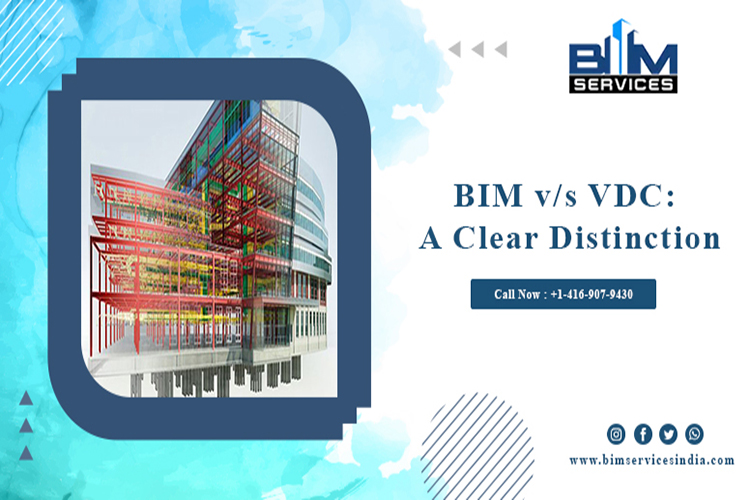BIM v/s VDC: A Clear Distinction

Thanks to the recent boom in revolutionary technological inventions and innovations, the construction industry is having a great time. As compared to just about a few decades ago, the industry has undergone a 360 degree transformation by adopting and implementing latest concepts like BIM and VDC. Architects, Engineers, Designers, and other construction professionals can now provide Architectural BIM Services with improved efficiency, effectiveness, coordination and collaboration.
Due to such constant and massive developments occurring over such a short period of time, a lot of chaos has been created in understanding and differentiating between similar developments in the field of construction.
Table of Contents
One such confusion is about the concepts of Building Information Modeling (BIM) and VDC (Virtual Design and Construction) as the former is often mistaken as the latter and vice versa. This article targets to clarify the distinction between the two in a simple but precise manner.
What is BIM?
Simply put, Building Information Modeling (BIM) is a comprehensive process concerned with enabling Architects, Structural Engineers and MEP Engineers to collaborate their planning efforts onto one digital model of the building project.
Software applications such as Revit, SketchUp, etc. facilitate users to implement BIM process in their project ventures.
The focus is on ‘Collaboration’
The software part of BIM is based on the central idea of providing ease of collaboration to users by providing a clear and universal form of communication between multi-disciplinary teams i.e. structural, architectural and MEP. It allows these professionals to integrate their individual efforts on a highly accurate digital 3D model of the structure that is yet to be built. This feature helps users minimize rate of errors and reworks by eliminating the possibility of mistakes caused by misinformation, use of outdated data, or delays in document delivery.
Such features allow for increased efficiency in collaboration between experts from all subject areas at the same time eliminating delays that used to occur while resolving constant overlaps due to the perpetual exchange of plans with updates between these disciplines.
Additional Benefits
The software enabling BIM process give easy remote access of information to concerned professionals from anywhere in the world. They can edit this information with certainty that the entire team working on the project will be updated with the same in real-time.
Professionals and firms providing BIM Modeling Services use BIM software to facilitate data analysis and problem resolution through clash detection even before any resources or manpower is committed to starting the construction phase of the building. This reduces possibility of human error as well as on-site clashes and inconsistencies during the construction phase.
3D BIM models are composed of smart or intelligent objects which have geometry and store data like scheduling, cost, sustainability and facility management. When these elements are modified, the entire BIM model is updated to reflect that change, thus further enabling collaboration, coordination and communication between all team members.
What is VDC?
Virtual Design and Construction (VDC) is a broader overreaching concept. It refers to the combination of BIM with an adequate work and management scheme known as PPM (Project Production Management) through ICE (Integrated Concurrent Engineering) which is a method that supports people working in an integrated and simultaneous manner.
It is an overall method of using computer technology to make the construction process increasingly coherent by focusing on achieving project objectives. It helps the clients achieve their goals. Simply put, VDC not only uses technology to build more efficiently while collecting data and tracking workflow progress but also digitizes the structure for smoother management and future renovation projects.
Differences between BIM and VDC
Owing to similarity in concepts, BIM and VDC are often confused and used interchangeably. Both are founded on the idea of collaboration and efficient communication but VDC is a broader concept that utilizes BIM as one of its many process stages.
VDC makes use of BIM models for planning of construction process from start to finish by accessing the associated dimensions of the model for data regarding budget, scheduling, cost estimation, sustainability and facility management. It utilizes this information for making crucial decisions, strategizing and systematically planning the entire lifecycle of the project with inputs from all concerned parties like architects, contractors, stakeholders, etc.
However, VDC, doesn’t necessarily always involve BIM. It can pick and choose other components of the process like planning, prefabrication and building documentation to improvise on traditional methods.
VDC is founded on the idea that virtual designing of buildings results in fewer mistakes, safer construction and more satisfied building owners. Additionally, the process accepts inputs from stakeholders and empower more part prefabrication, resulting in high-quality results at inexpensive rates.
Integration is Always Advantageous
To capitalize on the advent of modern technology and the opportunities it presents for the future, firms should invest in adoption of BIM as well as VDC. Both processes are closely related and work hand-in-hand to increase construction efficiency and quality, thus enabling professionals as well as companies to acquire and retain clients. Although VDC organizes the entire process of planning and execution, BIM is a crucial part of it that organizes the models and project documents used in the process and neither should be considered excusive of the other.